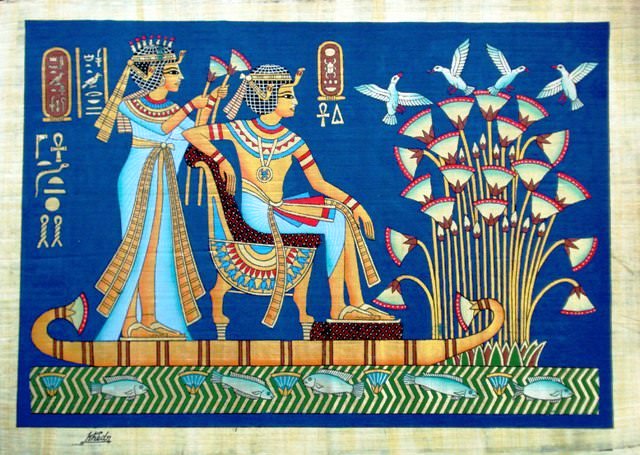Contents
The Egyptian Blue Lotus Flower is known to be a Psychoactive, and have been consumed in history at least since the time of ancient Egyptians. In Egyptian society, the Plant has been integral, with multiple mentions in the Book of Dead. King Tut’s body was found to be covered with the Sacred Blue Lotus petals when his tomb was opened in 1922.
In History
The Sacred Blue Lotus is Sacred to the Egyptian culture as a symbol of creation and rebirth. The Ancient Egyptians believed that the world was originally covered by water and darkness. Then a large Blue Lotus appeared in the water, the flower opened, and light appeared, thus ending darkness on earth. From the center of the Blue Lotus came the solar deities Atum and Ra. The Flower thus became a symbolic depiction of the origins of life. The Sacred Blue Lotus Flowers is widely seen throughout history as a common motif in Egyptian art and architecture.
Scientific information
- Common Name: Egyptian Blue Water Lily
- Type: Herbaceous Perennial
- Family: Nymphaeaceae
- Native Range: Northern and tropical Africa and certain parts of Asia
- Bloom Time: July to September
Nymphaea Caerulea, commonly known as Blue Lotus or Sacred Blue Lily of the Nile, is a tropical Water Lily which features day-blooming, star-shaped flowers, each with upright, pointed, light blue petals spread flat on the water surface. This Water Lily is native to northern and central Africa.
Roles of the Sacred Blue Lotus Flower
Not much scientific research has been done in regards to the Psychoactive effects of the Sacred Blue Lotus. Some interesting facts about the Sacre Blue Lotus are shared below:
- Antioxidant: Chemical analysis of the Sacred Blue Lotus (Nymphaea Caerulea) shows that the Plant contains more than 20 different antioxidants, including phenols, flavonoids, saponins, anthraquinones, and anthocyanins.
- Brings Happiness: Apomorphine has been described as a Psychoactive alkaloid and non-selective dopamine agonist, meaning it can bring on happy feelings. It can also help with tension. Nuciferine is another Plant alkaloid with similar effects, albeit non-psychoactive.
- Aphrodisiac: Many people consume the Sacred Blue Lotus as an aphrodisiac, although modern medicinal research has not confirmed the effectiveness in this aspect. Early research, however, suggests nuciferine, an alkaloid in the Plant, may particularly help enhance sexual performance. Although it is difficult to find scientific research on the popularity of the Sacred Blue Lotus Flower of the Nile on this specific aspect, the Sacred Blue Lotus Flower has been consumed as an aphrodisiac since ancient times, along with the reported mildly relaxing effect, naturally boosting mood.
- Lucid Dream: The Sacred Blue Lotus Flower is said to help people induce or enhance lucid dreams. No research regarding this exists, but people report that tea made from the Sacred Blue Lotus Flower consumed before bedtime or having the Sacred Blue Lotus Flower in a vaporizer helped enhance dreams.
- Good sleep: The Sacred Blue Lotus has also been long-consumed for the purported ability to help people get a good night’s sleep. Specifically, users say they get relaxed good sleep.
- Muscle Control: Though not much scientific research on this subject has been performed, it is believed that two of the main compounds in the Sacred Blue Lotus, the alkaloids apomorphine, and nuciferine may assist with muscle control.
- Relieving Tension and restlessness: The Anecdotal pieces of evidence also strongly suggest that the Sacred Blue Lotus Flower has also been long-consumed to overcome tension and restlessness.
- Legal status: The U.S. FDA does not approve the Sacred Blue Lotus Flower to provide any treatments. In the U.S. as well as other countries the Sacred Blue Lotus Flower is not allowed to be consumed.
Conclusion
The Sacred Blue Lotus Flower has been known to be Psychoactive, which has been consumed throughout ages with recorded history from the Ancient Egyptians, and is known to induce lucid dreaming. It is known that the doses determine the Psychoactive effect of the Sacred Blue Lotus Flower.
As the Holy Medicine of the Holy and Divine Mother Ayahuasca, especially without the DMT admixtures, is known to provide mild Psychoactive effects, the Sacred Blue Lotus Flower also seem to provide similar result, although the details are unknown. It can only be presumed from history, the Sacred Blue Lotus Flower has been a revered Psychoactive.
References
- Agnihotri VK, Elsohly HN, Khan SI, Smillie TJ, Khan IA, Walker LA. (2008). Antioxidant constituents of Nymphaea caerulea flowers. Phytochemistry, [online] Volume, 69(10), p. 2061-6. Available at: https://doi.org/10.1016/j.phytochem.2008.04.009 [Accessed 19th July 2021].
- Bertol E, Fineschi V, Karch SB, Mari F, Riezzo I. (2004). Nymphaea cults in ancient Egypt and the New World: a lesson in empirical pharmacology. J R Soc Med, [online] Volume, 97(2), p. 84-85. Available at: https://dx.doi.org/10.1258%2Fjrsm.97.2.84 [Accessed 19th July 2021].
- Bjørklund G, Chirumbolo S. (2017). Role of oxidative stress and antioxidants in daily nutrition and human health. Nutrition, [online] Volume, 33, p. 311-321. Available at: https://doi.org/10.1016/j.nut.2016.07.018 [Accessed 19th July 2021].
- Poklis JL, Mulder HA, Halquist MS, Wolf CE, Poklis A, Peace MR. (2021). The Blue Lotus Flower (Nymphea caerulea) Resin Used in a New Type of Electronic Cigarette, the Re-Buildable Dripping Atomizer. J Psychoactive Drugs, [online] Volume, 49(3), p. 175-181. Available at: https://dx.doi.org/10.1080%2F02791072.2017.1290304 [Accessed 19th July 2021].
- Salehi B, Martorell M, Arbiser JL, et al. Antioxidants: Positive or Negative Actors? Biomolecules, [online] Volume, 8(4), p. 124. Available at: https://dx.doi.org/10.3390%2Fbiom8040124 [Accessed 19th July 2021].
- Zhang YJ, Gan RY, Li S, Zhou Y, Li AN, Xu DP, Li HB. (2015). Antioxidant Phytochemicals for the Prevention and Treatment of Chronic Diseases. Molecules, [online] Volume, 20(12), p. 21138-56. Available at: https://doi.org/10.3390/molecules201219753 [Accessed 19th July 2021].


